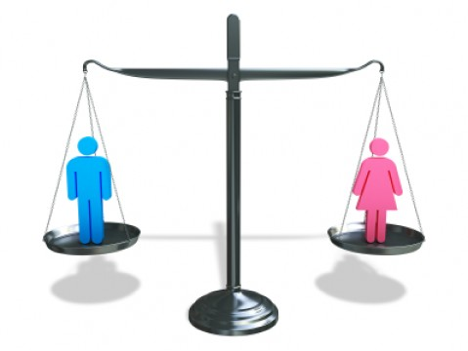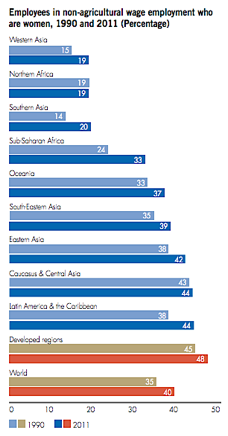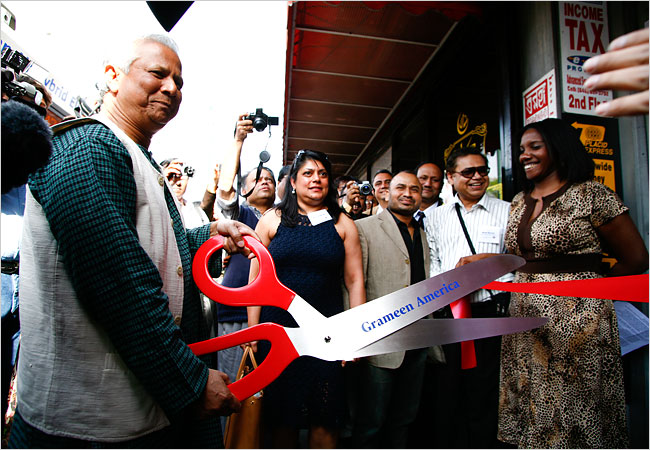
Established at the Millennium Summit of the United Nations in 2000, the Millennium Development Goals (MDG) are eight international development goals that member states and international organizations have committed to help achieve by the year 2015. With the 2013 Millennium Campus Conference being held at Northeastern University, let us refresh ourselves on the current status of these eight goals, one day at a time.
3. Promote Gender Equality and Empower Women
In order to combat gender inequality, the UN has recognized target areas that can support the cause of the third MDG: primary and secondary education, job security, and strength of influence.

With the efforts being made to successfully overcome the second MDG of universal primary education, “considerable progress” has been made in recent years. According the 2013 MDG Report, the number of girls enrolling in primary school has risen from 47 percent to 75 percent between 1990 and 2011, while the rate for boys rose from 58 percent to 79 percent; despite this however, the UNDP notes that for every 100 boys, only 93 girls are enrolled in primary school. Although the aforementioned progress has been made by global efforts, girls in Northern and sub-Saharan Africa, as well as Western Asia continue to be barred by restrictions to schooling, while in comparison, East Asia continues to be the only developing region where girls have greater access to primary education than boys. Notably, the disparity between girls and boys only becomes greater at the higher levels of education, compared to primary and secondary levels. In regions such as Latin America, Central Asia, and Northern Africa, more women are enrolled in higher education than men, while in Western and Southern Asia, women are less likely to move on to higher education.
The UNDP reports that the number of women establishing themselves in the labor market is increasing, but only in select regions and select areas of work. In 2011, 40 out of every 100 jobs in the non-agricultural sector were held by women; a significant improvement from 1990, when only 35 out of 100 of these jobs were held by women. Unsurprisingly, the numbers vary by region with areas such as Central Asia and Latin America where job parity between men and women has been “nearly achieved,” while sub-Saharan Africa and Southern Asia continue to fall behind, although they are improving. Preliminary estimates made in 2012 have shown that “income-earning opportunities” for women have increased, with 85 percent of women and 70 percent of men in sub-Saharan Africa holding total employment; but this does not mean that the jobs being held by women are secure or decent. In fact, many of the jobs that women hold have little to no social or security benefits, giving an advantage to men when opportunities are offered. From lack of childcare facilities to maternal health support, social rights continue to play a big role in women’s participation in the labor force.

Women assuming power in world parliaments has been established to be a credible source of studying gender equality, and in 2012, the world saw a rare increase of women in parliament. As of 2013, the average number of women in parliment was at 20.4 percent, a rise from 19.6 percent the year before. Today, only six parliamentary houses have no women members: Haiti, Micronesia, Nauru, Palau, Qatar and Vanuatu. Breaking away from this group is Saudi Arabia, after appointing women to the Shura Council for the first time in 2011, with women accounting for 20 percent of the country’s parliament. In addition, the UNDP reports that the highest electoral gains for women in 2012 were found to be in Senegal with women taking up 43 percent of parliamentary seats, Algeria with 32 percent and being the only Arab country to have passed beyond 30 percent, and Timor-Leste with 39 percent of its seats held by women. Beyond the issue of women’s influence in social and political change, the efforts in improving women’s decision-making power at home leaves much to be done. The 2013 MDG report notes that women continue to be denied opportunities in making decisions that affect their lives. The world has recognized that women’s “bargaining power” in their homes contribute to improvements in child literacy, survival rates and nutrition but in nations such as those in Africa, women continue to hold less influence than men, from issues of household purchases to even their own health.
Beyond the UN, governments themselves have begun establishing movements and supporting initiatives in order to spread the message of gender equality. An example of this is the government of Afghanistan and their attempts to reach out to religious elders in order to extend awareness of women’s rights “in accordance with Islamic laws.” The national program has been implemented by the Ministry of Haj and Religious Affairs and the Ministry of Women’s Affairs, having religious and community leaders educate citizens on issues such as early and forced marriage, as well as violence against women. The 2009 project is part of a $3.1 million UNDP initiative in partnership with the government of Afghanistan, which involves the training of leaders in order to fully educate the population and foster group discussions on women’s rights in the context of Islam.
Today, the joint program of the UNDP and Afghanistan has spread to over 3,900 community leaders in six provinces and is continuing to grow as dedicated citizens, organizations and the government itself, come together in the hope of further strengthening women’s rights. From education to job security, the MDG of achieving gender equality and empowering women can fulfill the 2015 target with continued cooperation of national governments, most especially those in religious regions. Although the number of women holding jobs has increased substantially, supporting women in actually keeping those jobs continues to be a challenge due to maternal health issues and the lack of imperative social benefits that can make women appear “unattractive” as employees. Finally, it is possible that the influence of women in their households and beyond will be the final push to get make the third MDG a success, but not without the proper implementation of laws related to sexual health, inheritance and property ownership.
Kaoru Inoue
International Affairs ’17
UN Department of Public Information, “Millennium Development Goals and Beyond 2015 Fact Sheet.” http://www.un.org/millenniumgoals/pdf/Goal_2_fs.pdf.
United Nations Development Programme, “In Afghanistan, mullahs use Islam to protect women and their rights.” http://www.undp.org/content/undp/en/home/ourwork/womenempowerment/successstories/in-afghanistan–mullahs-use-islam-to-protect-women-and-their-rig/.
United Nations Development Programme, “Millennium Development Goals.” http://www.undp.org/content/dam/undp/library/MDG/english/mdg-report-2013-english.pdf.


